|
The slides and associated videos come from the 13th SDL Forum held in Paris from the 18th
to the 21st of September 2007. Full papers are available in the proceedings book available
from the SDL Forum Society
or Springer.
| Preview |
Title, authors, affiliation and country |
Abstract |
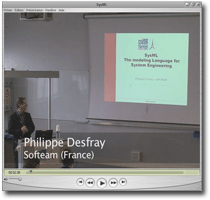
|
SysML Tutorial
Systems Modeling Language
Philippe Desfray
Softeam, France
slides
video
|
Philippe Desfray is involved since 17 years in model driven development research,
standardization, and tooling. Co-founder of the SOFTEAM company (250 people in 2007),
he has been precursor to OO Modeling (inventor of the Class Relation OO model, 1990,
supported already at that time by a case tool), to MDA (with a technology called
Hypergenericity at that time (1994, Addison Welsey book on the matter, dedicated tool),
member of the UML standardization team at the OMG since the origin, and main driver
of the "UML profile" technology. Philippe serves as VP for R&D at SOFTEAM, is one key
expert in the modelling and methodology fields, and is driving R&D projects and the
Objecteering UML/MDA case tool development team.
|
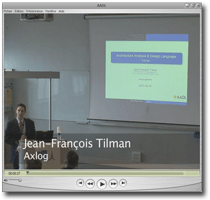
|
AADL Tutorial
Architecture Analysis and Design Language
Jean-François Tilman
Axlog, France
slides
video
|
Jean-François Tilman is a senior consultant at Axlog Ingénierie, where he manages
software and system engineering activities.He has been an active member of the AADL
standardization committee since its beginning, and is involved in several french
and european projects around AADL.He organized AADL workshops in 2002 and 2005,
and provides AADL training sessions for an education company.
|
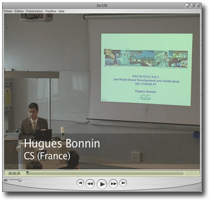
|
DO178 (B&C) Tutorial
Model Based Development and Verification
Hugues Bonnin
CS, France
slides
video
|
Embedded Software Expert for aeronautical activities for CS Communication and Systems,
he has an Engineering Degree in Computer Science from Institut d'Informatique d'Entreprise
(Evry, France). Since 15 years, his domains of work are industry, railway, automotive and
aeronautical.
He is involved in revision process of DO178-B, representing CS in the
international working group RTCA/EUROCAE SC205/WG71. He participates to the meetings, write
Issue Papers, and animates a local working group inToulouse, with Airbus. This very
intensive work allows him to meet all the Aeronautics main actors, the authorities people
from all over the world, and to be very aware of all certification issues.
He has participated, as architect and methodist, in the development of avionics software such as :
- Thales - Smiths Flight Management System "New FMS2" for Airbus A320/A340 under DO178B level C
- Flight Warning System for Airbus A380 under DO178B level C
His involvement in these projects allowed him to actively participate in the certification
process by supporting many audits and inspections with certification organisations.
He was also architect for other domains safety critical projects as: ERTMS (European Rail Traffic
Management System) Odometer for Faively Transport
|
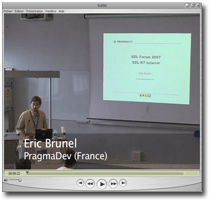
|
SDL-RT Tutorial
A combination of UML, SDL, and C/C++
Eric Brunel
PragmaDev, France
slides
video
|
Eric Brunel is co-founder and CTO of PragmaDev, and co-designer of the SDL-RT language.
He also participates in the ITU-T Study Group on System Design Languages. Before the company
creation in 2001, he had 10 years of experience as a project leader on development support
and modeling tools in a major company in the telecommunication industry. He is a specialist
in UML, SDL, and SDL-RT, and is an expert in object oriented development methodologies,
extreme programming, and test driven development.
|
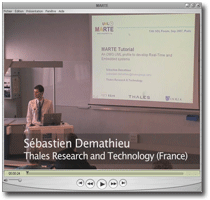
|
MARTE Tutorial
An OMG UML profile to develop real-time and embedded systems
Sébastien Demathieu
Thales Research & Technology, France
slides
video
|
Sébastien Demathieu is a software engineer at Thales Research & Technology. He has been
involved in the definition of the UML profile for MARTE and he is currently working on a
related experiment in the avionics domain, in the context of the System@tic competitive
cluster project: Usine Logicielle.Sébastien is also representing Thales in the OMG Systems
Modeling Language (SysML) Revision Task Force.Before he joins Thales, Sébastien worked on
tooling for pervasive application development at IBM Research. He experimented the use of
modeling technologies to support developments in that area. He contributed to different
prototypes and was involved in the industrialization of one of them, with IBM Software
Group.
Sébastien holds a Master's degree in Software Engineering from Pierre & Marie Curie University.
|
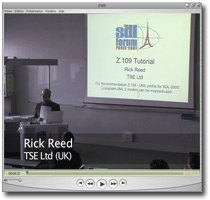
|
Z.109 Tutorial
An ITU UML profile to develop telecommunication and embedded systems
Rick Reed
TSE Ltd, UK
slides
video
|
Rick Reed is Director and consultant, of Telecommunications Software Engineering Limited.
He has several activities related to SDL (ITU-T Z.100, Z.105, Z.120), Telecommunications
software and systems design for Service/Protocol specification (such as ISDN, B-ISDN,
satellite, ATM, GSM, DECT), Software Methods, language design (such as SDL and CHILL
ITU-T Z.200) and formal description techniques:
- Various consultancy activities such as advice on SDL use and contract SDL design
work (Ascom, BT, Inmarsat, Motorola, Telematics, and others).
- ITU-T SG17 rapporteur for SDL (now Q.11/17 was Q.6/10 then Q.13/17).
- Head of UK delegation (for DTI) to ITU-T for SG17 and (previously) SG10.
- Board member of SDL Forum Society (Chairman since Jun01).
- European Commission framework projects reviewer.
- SDL client site courses.
|
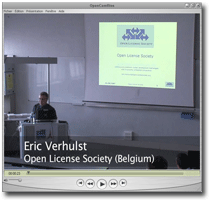
|
OpenComRTOS: An ultra-small network centric embedded RTOS designed using formal modeling
Eric Verhulst
Open License Society, Belgium
slides
video
|
OpenComRTOS is one of the few Real-Time Operating Systems (RTOS) for embedded systems that was developed using formal modeling techniques. The goal was to obtain a proven trustworthy component with a clean and high performance architecture useable on a wide range of networked embedded systems. The result is a scalable communication system with real-time capabilities. Besides a rigorous formal verification of the kernel algorithms, the resulting architecture has several properties that enhance the safety and real-time properties of the RTOS. The code size in particular is very small and typically 10 times less than a typical equivalent single processor RTOS.
|
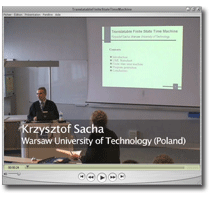
|
Translatable Finite State Time Machine
Krzysztof Sacha (Warsaw University of Technology, PL)
slides
video
|
The paper describes syntax, behavior and formal semantics of a new class of timed automata, which are tailored for modeling the behavior of real time systems. A formal method for automatic generation of programs is developed around this model. The method starts from modeling the desired behavior of the system under design by means of an UML-based state machine with the ability to measure time, and ends-up with a complete program written in one of the IEC 1131 languages. The translation process is done automatically, and the semantics of the resulting program is isomorphic to the semantics of the model.
|
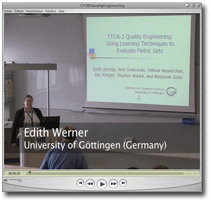
|
TTCN-3 Quality Engineering: Using Learning Techniques to Evaluate Metric Sets
Edith Werner
(University of Göttingen, DE)
Jens Grabowski
(Universität Göttingen, DE)
Helmut Neukirchen
(University of Goettingen, DE)
Benjamin Zeiss
(University of Goettingen, DE)
slides
video
|
Software metrics are an essential means to assess software quality.
For the assessment of software quality, typically sets of
complementing metrics are used since individual metrics cover only
isolated quality aspects rather than a quality characteristic as a
whole. The choice of the metrics within such metric sets, however,
is non-trivial. Metrics may intuitively appear to be complementing,
but they often are in fact non-orthogonal, i.e. the information
they provide may overlap to some extent. In the past, such redundant
metrics have been identified, for example, by statistical
correlation methods. This paper presents, based on machine learning,
a novel approach to minimise sets of metrics by identifying and
removing metrics which have little effect on the overall quality
assessment. To demonstrate the application of this approach, results
from an experiment are provided. In this experiment, a set of
metrics that is used to assess the analysability
of test suites that are specified using the TTCN-3 is investigated. |
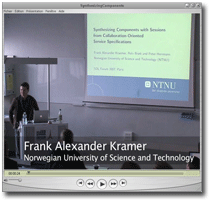
|
Synthesizing Components with Sessions from Collaboration-Oriented Service Specifications
Frank Alexander Kraemer (NUST, NO)
Rolv Braek (NUST, NO)
Peter Herrmann (NUST, NO)
slides
video
|
A fundamental problem in the area of service engineering is the so-called cross-cutting nature of services, i.e., that service behavior results from a collaboration of partial component behaviors. We present an approach for model-based service engineering, where system component models are derived automatically from collaboration models. These are specifications of sub-services incorporating both the local behavior of the components and the necessary inter-component communication. The collaborations are expressed by UML collaborations and activities in a compact and self-contained way. The UML activities are also well-suited to express service compositions precisely, so that components may be derived automatically by means of a model transformation. In this paper, we focus on the important issue on how to coordinate and compose collaborations that are executed with several sessions at the same time. We introduce an extension to activities for session selection. Moreover, we explain how this composition is mapped onto the components and how it can be translated into executable code.
|
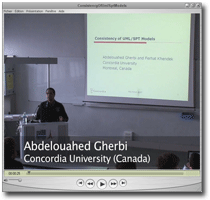
|
Consistency of UML/SPT Models
Abdelouahed Gherbi (Concordia University, CA)
Ferhat Khendek (Concordia University, CA)
slides
video
|
UML supports a multi-view modeling approach for overcoming
software complexity. It consists of several diagrams, which allow
for considering software systems from different perspectives: structure,
behavior and deployment. However, this multi-view approach faces
the challenging issue of consistency. Moreover, when UML is used for
real-time systems, through its specialized profiles such as UML/SPT
for instance, the consistency issue becomes more complex. New aspects,
relevant for real-time systems design, should be taken into consideration.
These include concurrency, time constraints and schedulability. In
this paper, we present a consistency framework for the UML profile for
real-time systems. This framework addresses incrementally the various
aspects of consistency for a UML/SPT model including syntactic, semantic,
concurrency-related and time consistency. In this framework, we
introduce an approach for checking time consistency between statecharts
and sequence diagrams using schedulability analysis while taking into account
deployment constraints.
|
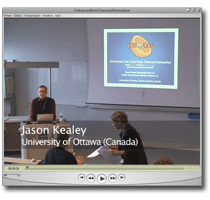
|
Enhanced Use Case Map Traversal Semantics
Jason Kealey (University of Ottawa, CA)
Daniel Amyot (University of Ottawa, CA)
slides
video
|
The Use Case Map (UCM) notation enables the use of graphical scenarios to model grey-box views of a system's operational requirements and behaviour. The scenario traversal mechanism is the most popular UCM analysis technique but its implementation in UCMNav is limited and hard to use, and the high-coupling of its features makes it difficult to maintain and evolve. This paper introduces major analysis enhancements to the recent jUCMNav Eclipse plug-in by providing an extensible scenario traversal semantics accompanied by improved model transformations to Message Sequence Charts. Furthermore, this paper identifies a set of semantic variation points for which the behaviour is unclear in UCMs, laying the groundwork for notational clarifications and user-defined semantic profiles.
|
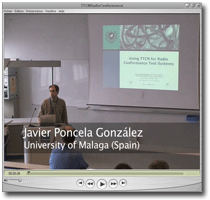
|
Using TTCN for Radio Conformance Test Systems
Javier Poncela González (University of Malaga, ES)
Carlos Valero Roldán (University of Malaga, ES)
Unai Fernández Plazaola (University of Málaga, ES)
Juan Gómez Salvador (University of Malaga, ES)
slides
video
|
While protocol conformance testing methodology is a well formalized field, radio testing methodology still relies on natural language specifications. This paper proposes an improvement on the quality of radio test specifications via the use of formal notation TTCN. This approach, and the fact that protocol and radio conformance testing share most of the underlying concepts, enables the use of a generic architecture for implementations of both types of testers, resulting in a reduction of the development efforts. This architecture has been validated with the implementation of radio test cases for the UMTS technology. |
|














